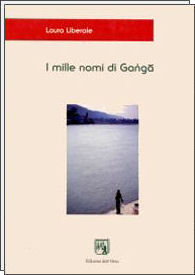 I just read "The Thousands name of Gaṅgā" (I mille nomi di Gaṅgā) by Laura Liberale. The first part of the book recounts the myths about Gaṅgā, whereas the second is an Italian translation of the Gaṅgāsahasranāmastotra ('the hymn of the thousands names of the Gaṅgā', a list of thousand names of Gaṅgā, in alphabetic order and with no further notation) of the Skandapurāṇa. The translation is followed by an appendix reporting the Sanskrit text of the 1908-9 edition of the Skandapurāṇa, together with variants found in twenty manuscripts.
I just read "The Thousands name of Gaṅgā" (I mille nomi di Gaṅgā) by Laura Liberale. The first part of the book recounts the myths about Gaṅgā, whereas the second is an Italian translation of the Gaṅgāsahasranāmastotra ('the hymn of the thousands names of the Gaṅgā', a list of thousand names of Gaṅgā, in alphabetic order and with no further notation) of the Skandapurāṇa. The translation is followed by an appendix reporting the Sanskrit text of the 1908-9 edition of the Skandapurāṇa, together with variants found in twenty manuscripts. The author notes:
- 1) that H.T. Bakker (working on the critical edition of "the most ancient edition of the Skandapurāṇa", dated "to the VIII or even VI c.") told her that the Gaṅgāsahasranāmastotra is not present in this "original" version (p. 195).
- 2) that, "therefore", "this stotra does not seem to precede the XIII-XIV c." (p. 195).
I am not sure that 2) follows from 1), although the author might have additional reasons she does not mention here, i.e., the chronology of nāmastotras (hymns listing names) in general. But, if so, the absence of the Gaṅgāsahasranāmastotra from the ancient version of the Skandapurāṇa edited in Groningen does not seem to add much.
- 3) Next, she notes that the text has been handed down "with a extraordinary honogeneity of sources" (i.e., with little variants).
However, the twenty manuscripts are all manuscripts of the Gaṅgāsahasranāmastotra, separated from the Skandapurāṇa, they are all written on paper and in Devanāgarī. Moreover, 12 out of 20 come from the same library (Indira Gandhi National Centre), 2 come from Poona (Bhandarkar Oriental Research Institute), 2 from Trivandrum (Oriental Research Institute), 1 from Kerala (Oriental Research Institute and Manuscripts Library) and 2 from the on-line archives of the university of Pennsylvania. I wonder whether the uniformity depends only on the relatively recent age of the text (do you know of recent religious texts with many variants?) or on the particular manuscripts examined, which might all be related. Unfortunately, the author does not attempt a stemma codicum, nor does she explain how representative is the number of manuscripts examined, if compared to the total amount of manuscripts of the same text.
- 4) The author writes (p. 12) that she has found and examined all manuscripts.
Why are the data (such as number of pages, lines per page…) missing in the case of the manuscripts from the BORI and from Trivandrum?
This being said, the section about manuscript is rightly called an "appendix" and readers immediately understand that the author cares much more for the content of the Gaṅgāsahasranāmastotra and for its focus on the feminine aspect of the Divine.
—What do you think of the possibility of critical editions of nāmastotras?
—Does it make sense to collect variants, if one is not interested in a complete recensio, nor in a genealogy of manuscripts? Please remember that life is short and the time spent in doing X is time one is not dedicating to Y.
On the need of priorities, see this post. For my review of this book on Amazon.it. click here.


No comments:
Post a Comment